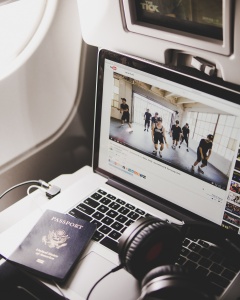Is it safe to use a plane’s Wi-Fi?

From the Balearics to Bahrain, millions of Brits are heading abroad this summer, despite the chaos at airports around the country. Whether you want to do some work or stream a movie, it can be tempting to connect to the plane’s Wi-Fi. But is it really safe? And if there’s no alternative, what can you do to help protect your data?
The internet became a mainstay in many households by the late 1990s. However, most commercial airlines didn’t introduce Wi-Fi until at least 2008.
How does a plane’s Wi-Fi work?
Planes connect to Wi-Fi using antennas. These gather signals from the nearest transmitters. They then send the information to an onboard router which helps spread Wi-Fi signals
throughout the plane.
There are two main operating systems:
Ground-based – This operates in a similar way to mobile data. The plane antenna is like a hotspot as it picks up signals from cell towers.
Satellite – This form of Wi-Fi technology tends to be the most common when travelling across large bodies of water. Using a network of satellites, the plane’s antenna catches the signals from the nearest one.
Like any form of public Wi-Fi, there is a risk posed to those who connect. Cyber-criminals take advantage of the lax security because most public Wi-Fi networks aren’t secured.
How to increase security, when using a plane’s Wi-Fi
Whether you’re flying short or long haul, not being able to connect to the internet can feel uncomfortable. Especially when we’re used to browsing for more than 6 hours a day.
Here are our top tips to help you stay safe when browsing in the sky.
Only use secure sites – HTTPS sites have an additional layer of security making them harder to hack. Avoid using HTTP sites: they aren’t as secure and provide hackers with an easy entry point.
Use a VPN – Installing a VPN helps to encrypt data sent between your device and the server. This virtually impenetrable security layer means you can scroll safely at altitude.
Click ‘public network’ – Before connecting to your airline’s Wi-Fi, make sure you’ve designated it a ‘public network’. Choosing this option will turn off a number of file-sharing capabilities to reduce the chances of compromised data. The public network setting can also hide your device from other computers and phones.
Update firewalls – If you’re thinking about using public Wi-Fi at the airport or on the plane, make sure your firewalls are up to date. Having robust anti-spyware and antivirus software will help you have a stress-free holiday.

